Why Steam?
Without steam in your oven, your rustic hearth bread will never have the appearance, volume, and crust you want.
Commercial wood fired bakeries in Europe commonly have steam injection systems to manage the look of their bread and ensure proper crust development and caramelization. This type of system is out of reach for home bakers, and even for most micro-bakeries. However, that does not mean we can’t get good results with much simpler methods.
When our oven hearth is fully loaded with bread, the dough itself creates a fair bit of steam as it bakes, but it’s usually still not enough.
Here’s the procedure we follow. It has proven both successful and consistent.
Techniques for Creating Steam
- First, all ash and coals are raked out of the oven. When the optimum hearth temperature is very close, we brush the hearth clean, swab it very quickly with a damp (not wet) piece of towel attached to a handle to remove residual ash, and then seal the door.
- About ten minutes before the bread are loaded, we give the interior a ten-second spray from a dedicated garden sprayer with a brass wand, reaching in with the wand to the back of the hearth, then moving forward toward the mouth of the oven. The door is re-sealed. Depending on the size of your oven, you may not need something as large as a garden sprayer, and a plastic spray bottle might be sufficient. Be sure to wear oven gloves that reach up your forearms when you do this. There should be visible steam in the chamber.
- Alternately, you can put an old sheet pan loaded with clean, damp rags into the oven to generate steam (although this is not the traditional method.)
- Once you have loaded your bread into the oven, add more steam with another ten-second spray. Don’t spray the bread directly. Instead, point the nozzle above them, about halfway between them and the dome. Seal the door as tight as you can. If you have trouble getting a good seal, lean a brick against the door.
Baking Science: How It Works
- It’s often said that injecting steam into a brick or modular oven will cause bricks to crack or cast refractory pieces to shatter. In point of fact, the water never touches the interior surfaces; it immediately bursts into steam in the superheated air. If there were such risks involved, it’s very unlikely that large European bakeries would use the technique.
- Steam keeps the surface of the bread moist for the first crucial few minutes of baking. Moisture allows the heat from the hearth to drive the gasses upwards inside the dough, expanding the loaf to create tremendous volume through ’oven spring.’ Once the steam dissipates, the crust sets, caramelization of the sugars in the grain starts and the formation of a characteristically chewy crust begins. After experimentation, you might find that another quick spray, about five minutes into your baking time, improves the results.
- Conversely, for hearth bread, you want them to finish baking in a dry environment, so crack the oven door open slightly during the last few minutes or so to finish the crust.
- It’s a difficult rule to follow, but all bread should be allowed to cool completely on wire racks before slicing. If you don’t wait, the flavor will not be fully developed and the texture will be off, as the cooking continues while the bread cools.
That’s enough on Techniques, let’s make some bread, starting with Biga Whole Wheat Toasting Bread.
Back Forward
Multi-grain breads made with a wheat sourdough starter do not rise as high as loaves made entirely with hard, unbleached bread flour and a white leaven. However, the loaf volume shown in this example would not be nearly as great without the oven spring produced by steam in the baking chamber.




